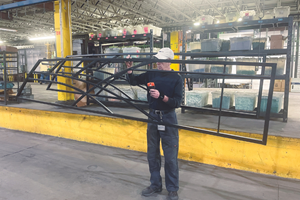Benefits of Powder Coating
If you’ve done your homework, carefully analyzed your options and decided to use powder coating as a surface finish, where do you start?
If you’ve done your homework, carefully analyzed your options and decided to use powder coating as a surface finish, where do you start?
By the time you’ve made this decision, you will likely have talked powder with your liquid paint supplier and, if they also sell powder, they’ve helped you understand what powder to use and what you may need in the way of pretreatment process and curing oven changes. He may also have pointed you in the direction of a powder application and recovery equipment supplier.
If your process needs include a conveyorized continuous paint line you may be best served by contacting one of the many highly qualified systems houses (or systems integrators) who will help guide you through the complexities of integrating pre-treatment, ovens, application and recovery booths, and material handling into one complete system that meets your needs.
Putting IT ALL together
If your coating needs include only batch processing, you may be able to put the pieces of the puzzle together on your own by contacting equipment and process supplier companies directly.
Since my area of expertise is in the application equipment and recovery booth portion of the industry, I’ll leave the discussion on pretreat, ovens, and conveyors to others. From an application equipment point of view, there are many things to consider.
Certainly, you’ll want to make sure you are matching available technology to those of your needs. I’m not a big fan of buying the latest technologies just for technology’s sake. Make sure the “bells and whistles” provide actual value to your needs. Most powder coating systems on the market today are capable of 100 kV charging, which for simple coating applications, translates to giving you the highest possible transfer efficiency.
However, if the parts you are coating are of irregular shapes with many Faraday cage regions, or if thicker coatings are specified, you’ll need a gun system that addresses these issues. Most reputable suppliers have methods or technologies available to overcome the most common coating difficulties. Be sure to talk with potential suppliers about their technology and have them back them up with demonstrations on your parts. Ask suppliers about their product reliability, operational simplicity, robustness, and “life cycle cost.”
The ideal environment
When it comes to applying powder, the ideal environment would be in the middle of a large room with absolutely no air movement to interfere with the powder flow, plenty of high quality lighting, and a perfect part grounding system. This, however, is not reasonable or acceptable in the real world, so we always apply powder within a booth enclosure. Simply put, the purpose of a powder coating booth is to provide a safe environment where powder overspray can be contained with just the right amount of capture air flow and as quiescent a powder application zone as possible. Beyond that, the sky is the limit when it comes to booth design philosophy.
Powder coating booths should meet NFPA 33 Standards, be constructed of materials that will not adversely affect your coatings or plant environment, and should provide for a safe and relatively quiet environment where workers will be exposed eight or more hours per workday.
There are many significant decisions to be made before you can solicit bids on your booth. Are you going to try and reclaim oversprayed powder? The decision to reclaim adds significant cost to your booth. Make sure the savings exceed these costs within your defined time period. Are you considering an automatic booth? How many guns will you need? Will you need manual touch up painters? Many of the up-front decisions can be empirically determined, however nothing beats seeing your parts coated in a demonstration environment.
Finally, the Powder Coating Institute (powdercoating.org) offers a “Powder Coating 101 Hands-on Seminar” several times a year. This valuable seminar features classroom training on all aspects of powder coatings by industry experts along with several hours of hands-on spraying of parts in both a manual and automatic environment. Taking one of these courses will go a long way to getting you moving in the right direction and giving you the basic information you need when talking with potential suppliers.
John Cole is president of Parker Ionics (Westland, MI), a developer, manufacturer and distributor of technologically advanced powder coating equipment. He can be reached at 734-326-7630, or online at parkerionics.com.
Related Content
Curing Oven Basics
Simply heating up the substrate does not cure the coating. There are many variables to consider when choosing the best cure oven for your application...
Read More‘Warming Up’ to the Truth about Ovens for Surface Treatment
Understanding the different types of oven heat technology for surface finishing, including how they work, and their advantages and disadvantages, can help determine the best heating solution for an application.
Read MorePowder Coating Overcomes Post Forming
Six Sigma methodology, open communication, and collaboration produce results for leading boat manufacturer.
Read MoreOven System Wins Pace Award
The EcoInCure is designed to cure complex car bodies with superior paint quality faster and more efficiently than conventional ovens.
Read MoreRead Next
Episode 45: An Interview with Chandler Mancuso, MacDermid Envio Solutions
Chandler Mancuso, technical director with MacDermid Envio discusses updating your wastewater treatment system and implementing materials recycling solutions to increase efficiencies, control costs and reduce environmental impact.
Read MoreDelivering Increased Benefits to Greenhouse Films
Baystar's Borstar technology is helping customers deliver better, more reliable production methods to greenhouse agriculture.
Read More





















